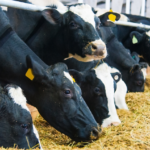
Eggs – Organic, Cage–Free, Free-Range… What’s The Difference? Part One
Organic, Cage–Free, All–Natural, Free Range…trying to decide which eggs to buy at the supermarket can feel a lot more like a word puzzle than a trip to the grocery store! These terms are frequently mentioned, but also frequently misunderstood. They are discussed in the news, legislature, and many experts are researching them as there is a lot of buzz about how eggs are produced
We took an in-depth look at each of the terms and asking experts their professional opinions, as we know consumers are interested in learning about the lives of hens that produce these eggs for us to eat. We’ll embark on a three-part series to get to the bottom of the questions we’ve received and the general scope of this topic.
So what are the most common ways hens are raised to produce eggs? We’ll look at the top four types of barns and get expert insights on the advantages and disadvantages to each.
The experts we enlisted for this post are Dr. Darrin Karcher professor at Michigan State University and Dr. Patricia Hester, professor of Animal Sciences at Purdue University. Dr. Karcher describes the systems used for laying hens, while Dr. Hester gives the advantages and disadvantages to each.
Conventional Cages
This system provides 67-86 square inches per bird, as well as continuous feed and water. Dr. Karcher explains that the industry currently uses the conventional cage system most frequently.
- Advantages:
- Hens have fewer incidences of cannibalism because of smaller group sizes.
- Cages provide protection from predators and wildlife.
- Hens housed in cage housing systems are at a lower risk of infectious disease.
- Conventional caging does not incorporate the use of litter. Litter-based systems have been shown to have increased levels of ammonia, dust and bacteria.
- Hens in cages have improved livability
- Disadvantages:
- Restriction of natural behaviors: Hens in cages are less able to perform behaviors such as dust bathing and foraging.
- Nesting and roosting are not options in the conventional cages.
- Hens may experience overgrown claws.
- Caged hens have poorer skeletal health because of lack of exercise.
Enriched Colony Housing Units
This system provides around 116 to 144 square inches per bird again with constant feed and water. But there are perches, a forage mat or scratch pad area, as well as a nest box or an area where the birds can have some privacy to lay eggs. Abrasive strips are provided to keep claws trimmed.
- Advantages:
- Hens are better able to express their natural behaviors such as nesting, foraging, and perching than in conventional cages
- Perches: Hens are motivated to perch, especially to roost at night. Perches improve bone strength
- Disadvantages:
- Foraging behavior and dust bathing are not expressed as easily as in cage-free systems.
- Nest-dwelling parasites can be a problem.
Cage Free
There is a colony nest box which usually runs down the center of the house with a slatted area where the feed and water are located so the hens then can go into this nesting area to lay their eggs. Aviaries also fall into the category of cage-free housing where hens can use vertical space to access one or more tiers consisting of wire or perforated floors or platforms. A littered area for scratching is available in cage-free systems.
- Advantages:
- Barn – and – aviary raised hens show improvement in bone strength, but more bone breakage occurs because of increased activity over hens raised in cages.
- Increased ability to forage and dust bathe.
- Disadvantages:
- Birds raised on the floor are more likely to encounter disease carriers in feces or dampened litter, potentially leading to reduced health.
- Cannibalism and pecking is greater in cage-free systems.
- Litter – based systems have been shown to have increased levels of ammonia, dust, and bacteria.
Free-Range
The key feature of free-range housing is access to an outdoor area during the day.
- Advantages:
- Hens with access to both indoor and outdoor areas have the greatest range of behavioral opportunities. Hens that spend more time outside have better feather condition.
- Disadvantages:
- Outdoor conditions could potentially expose hens to toxins, wild birds and their diseases, predators, and climatic extremes. Hens are often reluctant to use the range area or venture far from the hen house resulting in wear of the pasture in the area near the house.
What type of eggs does your family buy? Tell us in the comments section!
This is the first post of a three-part series. Be sure to check out Part Two and Part Three.
Photo: “Organic Eggs China – Chicken Farm” by I a walsh is licensed under CC BY 2.0.



























